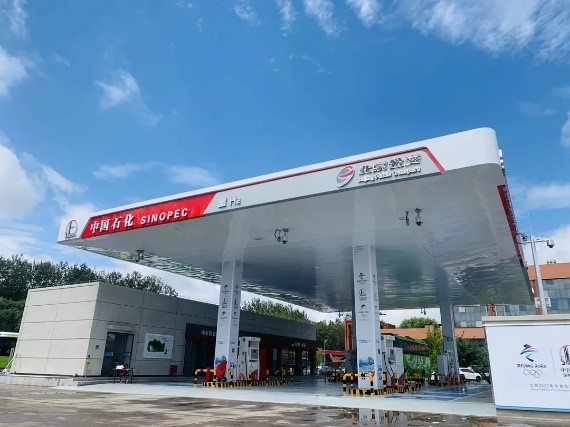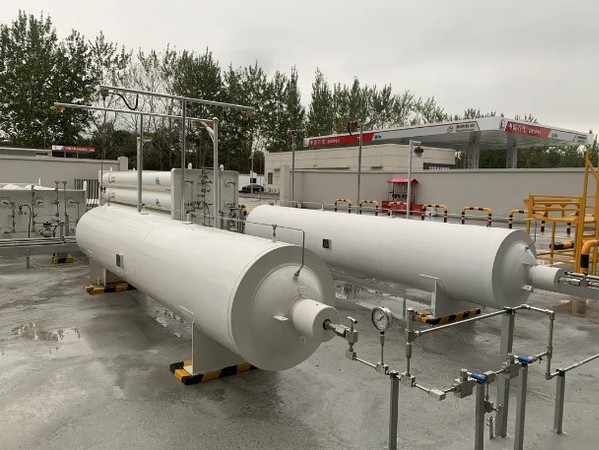ZJU scientists contribute their part to green and clean Winter Olympics (I)
[Editor’s Note: the Beijing 2022 Winter Olympics was officially opened on February 4. In addition to the crystal white world of ice and snow, the Beijing 2022 is featured by another bright color—green, the symbol of environmental protection. The Games embodies the concept of “greenness” in every dimension, such as ecology, buildings and transportation. This is the first installment of a two-part story, showcasing how ZJU scientists have contributed to a “clean and green” Winter Olympics.]
Green energy for Beijing 2022
On Beijing’s Qingyuan Street, a hydrogen fuel cell bus has just had its fill of energy and is slowly setting off from the station. This kind of bus is the embodiment of eco-friendliness. Loaded with 70MPa hydrogen cylinders, it can run more than 500 kilometers with one refill. Its mileage is comparable to that of a fossil fuel bus.

One of the key technologies in the hydrogen refueling station is to manufacture the hydrogen storage tank. In this regard, scientists from Zhejiang University, Zhejiang Juhua Equipment Manufacturing Co., Ltd., and Beijing Hydrosys Corp. provide four 98MPa/1 cubic meter hydrogen storage tanks for hydrogen refueling stations.
It is far from an easy task to build a 98MPa hydrogen storage tank with a volume of 1 cubic meter.
Since 2002, the team led by Prof. ZHENG Jinyang, a fellow of the Chinese Academy of Engineering at the College of Energy Engineering, has been committed to addressing two problems: high-pressure hydrogen embrittlement prevention , and safe and efficient hydrogen storage.

To store high-pressure hydrogen in a safe, economical and large-capacity manner, scientists need to prevent hydrogen embrittlement. “It will be exceedingly dangerous for the equipment if ductile material becomes brittle,” said Prof. Zheng. “Currently, the problem of hydrogen embrittlement cannot be completely tackled in technical terms. Therefore, it is of supreme importance to figure out its feature through testing.”
To this end, Prof. Zheng has led his team to invent an in-situ detection device for hydrogen embrittlement in the high-pressure gaseous hydrogen environment, propose the idea of designing a full multi-layer hydrogen storage vessel whose core is an anti-hydrogen embrittlement welded inner cylinder, and develop the built-in coupled ultrasonic phased array detection technology. In this way, they have created a complete technical chain of designing, manufacturing and inspecting high-pressure multi-layer vessels for hydrogen storage.
At present, the hydrogen storage tank developed by Prof. Zheng’s team is the largest in volume among those under the same pressure in the world. At Beijing 2022, these hydrogen storage tanks will give a thrilling account of themselves in green and clean energy.
Adopt Chinese standard in global procurement
Preventing and controlling noise to create a comfortable acoustic environment is an important consideration factor in building a harmonious living environment. It is also true of the Winter Olympics. Air coolers are usually installed to satisfy the needs of cooling equipment or venues. Therefore, it is essentially vital to choose cooling equipment that meets the requirements of venues for Beijing 2022. The sound power level is a core indicator for the assessment of equipment in noise control.

Dr. DI Guoqing, an associate professor in the College of Environmental & Resource Sciences, has long dedicated himself to research into the effects and control of physical pollution. In the procurement of air coolers for venues in Beijing 2022, he engaged in technical negotiations on the test method of sound power level for air coolers and undertook relevant testing work.
Dr. Di participated in the formulation of a national standard entitled “Acoustics— Determination of sound power levels and sound energy levels of noise sources using sound pressure — Engineering methods for an essentially free field over a reflecting plane”. By this standard, noise testing was conducted on relevant equipment for Beijing 2022.
In tests, sampling should be precise and scientific, and data analysis should be complete and accurate. “Each testing session should involve 32 measuring points evenly arranged on the regular hexahedron 2.6m away from the equipment shell. In order to obtain reliable and reproducible results, we need to carry out each test in accordance with the standard process,” Dr. Di recalled. “In order to reduce background noise as much as possible, we did every test at night, and it took about 6 hours to complete testing work for one single item of equipment,” he added.
“Standards are formulated for better production and life so that scientific research can be transformed into problem-solving productivity, which can in turn contribute to the improvement of living standards,” said Dr. Di.
Photos and video provided by the research teams